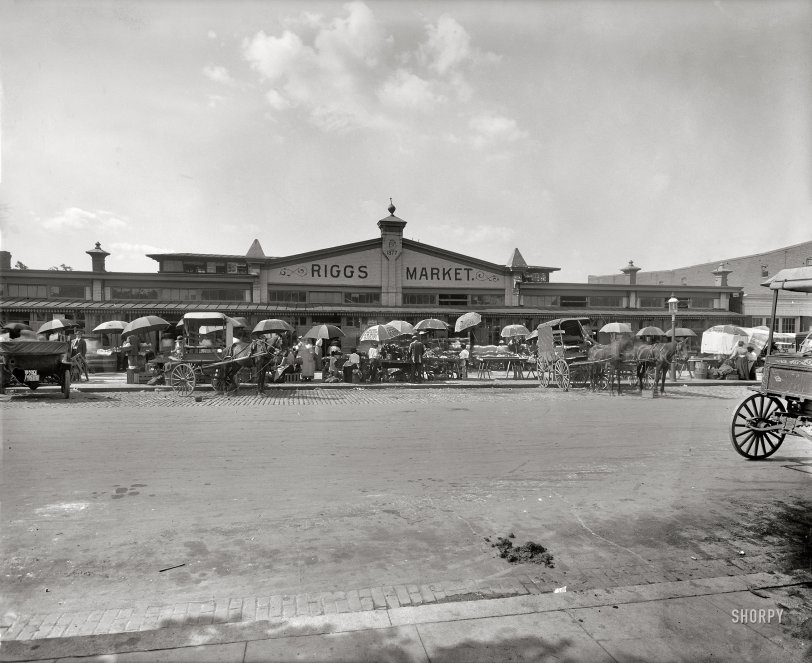


Framed or unframed, desk size to sofa size, printed by us in Arizona and Alabama since 2007. Explore now.
Shorpy is funded by you. Patreon contributors get an ad-free experience.
Learn more.

- Freeze Frame
- Texas Flyer wanted
- Just a Year Too Soon
- WWII -- Replacing men with women at the railroad crossing.
- Yes, Icing
- You kids drive me nuts!
- NOT An Easy Job
- I wonder
- Just add window boxes
- Icing Platform?
- Indiana Harbor Belt abides
- Freezing haze
- Corrections (for those who care)
- C&NW at Nelson
- Fallen Flags
- A dangerous job made worse
- Water Stop
- Passenger trains have right of way over freights?
- Coal
- Never ceases to amaze me.
- Still chuggin' (in model form)
- Great shot
- Westerly Breeze
- For the men, a trapeze
- Tickled
- Sense of loneliness ...
- 2 cents
- Charm City
- What an Outrage
- Brighton Park
Print Emporium
Riggs Market: 1915

Washington, D.C., 1915. "Riggs Market." On P Street N.W. between 14th and 15th since 1877, it closed in December 1945 to make way for an automobile showroom, according to the Washington Post. 8x10 inch glass negative, National Photo Company Collection. View full size.
Thanks for the insight!
tterrace, regarding the assumed cropping to take place after these large-format images were taken.
I've always been a full-frame composer. Working with 35mm pretty much required it. But high-end digital cameras are now emphasizing available crop-ability within their crazy-dense large sensors, while still producing a high-resolution image from the crop.
A century later, all we need now are the road apples.
How can you avoid it?
Is the question TerryCarroll imagines the photographer answering about the inessential material at the bottom. The answer for this and for all the other apparent extraneous imagery we often find in the full-frame scans of commercial photography here on Shorpy is that you don't have to avoid it. The images captured aren't final products, but raw material for use in producing printing elements for use in newspapers, advertisements, art prints and post cards, as just a few examples. In that process, the images can be cropped so that just what somebody wants to be seen is seen. In this one, we can assume that the intent was to capture as much as possible of the Riggs Market building; to do so the camera had to be as far away as possible. The photographer knew that the horse droppings were irrelevant. The final printed image, wherever it appeared, could be anything from a narrow horizontal strip to a small rectangle with just the center of the building. Without the horse pucky.
The Bricks are still on the Road
If you go to 1425 P St. NW, there is an old brick building there that looks like it used to be an automobile showroom. You can still see bricks on the street near the curbs on both sides of the street.
"Oh, that? Yeah, how can you avoid it?"
I've done my share of tripod-base landscape photography, but only with quick and easy 35mm film and equivalent digital cameras and certainly not something so cumbersome as an 8x10 with a glass negative! Nevertheless, when you set up a shot on a tripod, everything slows down, so you become aware of things like, "What's in the foreground?" And then you do a little arranging, or cleaning, to take care of unwanted distractions.
But I guess that in 1915, what's in the foreground was still so common that the several minutes it took to set up this shot -- on a big wooden tripod, focus under the black cloth, meter the light, etc. -- the organic matter (bearing two wheel tracks no less!) just disappears from consideration.
[Light meters as we know them today did not exist in 1915. - Dave]
At the end of his tether
My eyes can't turn away from that pathetically emaciated horse.
Anchors A-neigh
That horse to the left of the picture is racked up to an anchor, it seems.
No vinyl here
I noticed the wonderful decoration and striping on the front board of the buggy on the right. So nice. I am sure it was hand painted, no vinyl sticker or paint masks here.
Some history.
Everything Old is New Again
There's now a Whole Foods on the site.
























On Shorpy:
Today’s Top 5